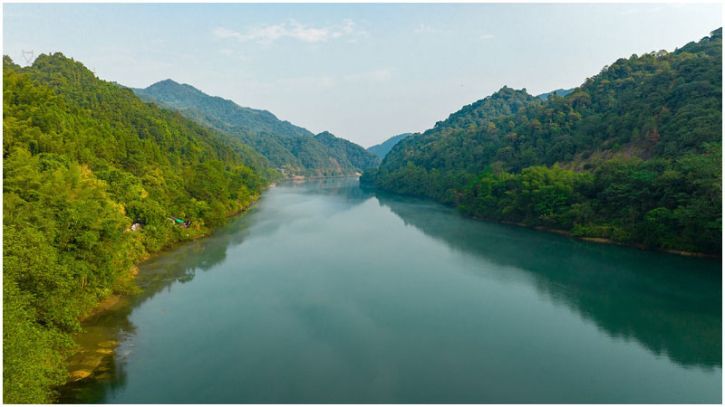Chinese expertise for our water management offers promising solutions

Water is the lifeblood of Bangladesh, a delta nation intricately woven with rivers and wetlands. Yet, this abundance of water has paradoxically become a source of distress due to rampant pollution, unsustainable extraction, and climate-induced challenges. To address these issues comprehensively, Bangladesh has sought expertise from China to develop a 50-year master plan for water management. This collaboration is a technical partnership and a strategic move that could redefine the country's future regarding water sustainability and economic resilience.
Bangladesh's water crisis is multifaceted and alarming. Groundwater depletion is one of the most pressing concerns. According to a joint study by the Directorate of Groundwater Hydrology and the World Bank, the country withdraws an estimated 32 cubic kilometers of groundwater annually, with 90 percent allocated for irrigation and the remainder used for domestic and industrial purposes. In Dhaka alone, the groundwater table is falling at an alarming rate of 2-3 meters per year, driven by excessive extraction to meet urban demands. By 2030, extraction rates are projected to increase from 5.9 million to 10 million cubic meters per day, potentially sinking the average groundwater depth to 132 meters, far beyond sustainable levels. Moreover, Bangladesh has already lost one-third of its groundwater within a decade, with predictions indicating a further decline of up to 115 meters by 2050. This rapid depletion threatens not only agricultural productivity but also the viability of industries reliant on water resources.
Pollution compounds these challenges. Arsenic contamination in groundwater affects millions, making it one of the largest mass poisonings in history. Coastal areas face additional threats from salinity intrusion due to rising sea levels and upstream freshwater withdrawal. In some regions, salinity levels have surpassed safe limits, rendering water unfit for drinking or irrigation. Heavy metal contamination from industrial effluents further deteriorates water quality, posing severe risks to public health and ecosystems.
China's expertise in water management offers promising solutions to these challenges. Over the past decade, China has transformed its water governance through innovative policies like the River Chief System (RCS).China has a six-tier water quality system, with water below Grade V classified as the worst quality. Surface water is considered to be of fairly good quality at Grade III or above.
This hierarchical system assigns local officials as "river chiefs" responsible for monitoring and improving water quality in specific rivers or lakes. The results are commendable; for instance, the Yangtze River's main stream consistently met Class II water quality standards for three consecutive years, while the Yellow River exceeded Class III standards. China aims to raise the proportion of surface water of fairly good quality to 85 percent by 2025 and eliminate surface water below Grade V quality-the worst classification-altogether. Additionally, plans are underway to recover water levels in 53 dried-up bodies and restore native fish species in 107 major aquatic ecosystems by 2025.
For Bangladesh, adopting elements of China's River Chief System could significantly enhance local governance of water resources. Tailored strategies such as "One River, One Policy," which emphasizes localized solutions based on specific river characteristics, could be adapted to Bangladesh's context. Furthermore, integrating advanced technologies like satellite monitoring and data analytics into water management systems could provide real-time insights into resource availability and pollution levels.
Economic benefits from improved water management are substantial. A study on irrigation practices in Bangladesh revealed that adopting efficient methods like alternate wetting and drying (AWD) could save approximately $140 million annually by reducing irrigation costs without compromising crop yields. Eliminating system losses in water distribution could save an additional $543 million annually. Proper conservation practices in local drainage channels (khal), small water bodies (beel), larger wetlands (haor), and ponds could add $362 million annually to the economy. Collectively, these measures have the potential to save over $1.34 billion annually.
Implementing a comprehensive master plan comes with challenges. Unlike China, which primarily manages domestic rivers, Bangladesh shares major rivers with neighboring countries like India and Nepal. Transboundary disputes over water allocation can complicate efforts to implement long-term strategies. Diplomatic negotiations will be crucial to ensure equitable sharing of resources from rivers such as the Ganges, Brahmaputra, and Meghna.
Institutional capacity is another critical factor. Effective implementation requires robust frameworks for monitoring progress and enforcing regulations across multiple sectors. Currently, many government agencies responsible for water management operate independently with limited collaboration-a situation that could hinder the execution of an integrated master plan. Moreover, funding remains a significant concern. Developing infrastructure for sustainable water management will require substantial investments that may exceed domestic budgetary capacities.
Despite these hurdles, seeking Chinese assistance reflects Bangladesh's forward-thinking approach. By leveraging China's expertise in sustainable development and ecological restoration, Bangladesh has an opportunity to address its pressing challenges while laying the foundation for long-term resilience.
The collaboration also holds geopolitical significance as it underscores Dhaka's willingness to diversify partnerships on critical infrastructure projects amidst shifting dynamics in South Asia. While India has traditionally been Bangladesh's closest ally on transboundary river issues through agreements like the Ganges Water Sharing Treaty (1996), China's involvement signals Dhaka's intent to explore alternative alliances.
In conclusion, Bangladesh's decision to seek a 50-year master plan from China represents both ambition and pragmatism in addressing its complex water challenges. If successfully implementedwith careful adaptation to local contexts, it could pave the way for sustainable resource use while improving public health outcomes and boosting economic growth across sectors such as agriculture and industry. Like any ambitious initiative, the journey from plan to reality will require commitment from policymakers alongside substantial investments into institutional capacity-building and regional cooperation.
The writer is a Lecturer, Department of Business Administration, Rabindra Maitree University, Kushtia.
Source: Daily Observer.
.png)




